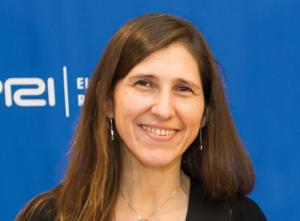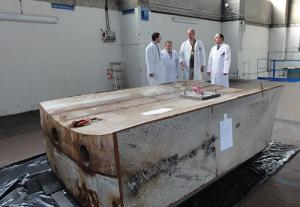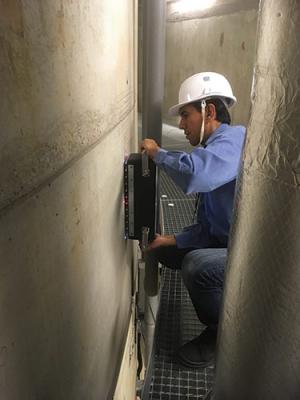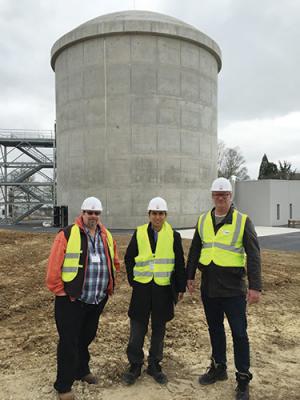EPRI
Maria Guimaraes Biagini is the program manager at EPRI’s Nuclear Sector for nondestructive evaluation of concrete structures.
PUF's Steve Mitnick: You're the program manager at EPRI's Nuclear Sector for nondestructive evaluation of concrete structures. What is your job like?

Maria Guimaraes Biagini: As structures age, we need to inspect them more often. As with any other material used in nuclear construction, inspecting by removing samples from the structure is not desirable. That is when nondestructive evaluation becomes a key factor in allowing us to inspect, for example a containment structure, without damaging it.
My job consists of leading a group of people that focuses on inspection and aging of civil structures in the energy sector. We start by having a thorough knowledge of how those structures were built and on how they age.
With regard to inspecting them, our first priority is to see whether the inspection is needed. The next step is to improve those inspections that are needed. The biggest challenges for us are that concrete is not a homogenous material; and that structures are large and many of them are buried, so accessibility is an issue.
PUF: Talk about some of what you and your team has invented here, that are advanced ways to check out these structures.
 EPRI’s Joe Wall (second from right) and scientists in the Czech Republic discussing plans for a section of a nuclear plant biological shield removed from service.
EPRI’s Joe Wall (second from right) and scientists in the Czech Republic discussing plans for a section of a nuclear plant biological shield removed from service.
Maria Guimaraes Biagini: I am so proud of this program we have created, and nothing would have happened if it were just me, because the team that is with me is more important than I am. I want to take this opportunity to give recognition to each of my team - Senior Technical Leaders Sam Johnson, Salvador Villalobos, and Joe Wall.
This team and its efforts began in 2009. I was just being hired when a delamination in a containment structure highlighted the need for reliable inspection of concrete structures. The plant asked us at the time, how can you help us?
At the time, there were some tools available but not known by us or to the nuclear industry. We had to look at what other techniques were out there. Were they reliable? Could they be used? When are they good to use? When are they not good? When will we be pushing the limits and when would we not?
That's how we started. Today, we have a concrete NDE lab with all types of different mockups that contain defects critical to testing for the industry.
 EPRI’s Sal Villalobos performing NDE tests in a concrete containment structure.
EPRI’s Sal Villalobos performing NDE tests in a concrete containment structure.
A big part of the success is the group we have created within EPRI and the network of our member advisors that are also part of the team as well.
This is not just me, and nothing would have happened if it were just me. Sal Villalobos has been inspecting all these nuclear plants and all these other structures for a long time, and he has a lot of field experience. Then there's Joe Wall, who is a material scientist that is able to look at degradations that are not at all common. He explores, for example, what does irradiation do to concrete? Then we have Sam Johnson, who has become our expert in aging management programs and license renewals and who has a lot of industry relationships.
PUF: Can this program be improved over the next few years?
Maria Guimaraes Biagini: Our industry is rooted in continuous improvement, so of course. This program has matured to where we put our focus a lot on technology transfer and enhancing that transfer with every new experience.
 (From left) EPRI’s Paul Weeks (also with EPRI’s NDE team) Sal Villalobos and Joe Wall during a visit to a large containment mockup built by one of EPRI’s members.
(From left) EPRI’s Paul Weeks (also with EPRI’s NDE team) Sal Villalobos and Joe Wall during a visit to a large containment mockup built by one of EPRI’s members.
We want to ensure that every EPRI member has the tools and the knowledge needed so they do not find themselves in the spot we were in during 2009.
As for new challenges, builders look for new ways to build structures, and often we find ourselves with structures that we cannot inspect. We are presented with the continual question of how can we inspect this type of building that is un-inspectable?
Other challenges we face are related to aging structures. As structures get older, parts you didn't necessarily inspect in certain ways, now you do have to inspect, so that's also another big part of what we're doing.
PUF: When you say new constructions from the builders, what are those?
Maria Guimaraes Biagini: Well, for example, take concrete containment. One new type of concrete containment is like a sandwich. It has two steel plates that are very thick on both sides and concrete is in the middle. When you need to inspect this sandwich structure nondestructively, it is not that easy, and we're working on solutions to that challenge.
PUF: Is it fun?
Maria Guimaraes Biagini: I love it, I love my work and I love working with the team, which as I said, includes our member advisors. But also, there are many global organizations and agencies that we are close collaborators with almost every day. That is how this lean EPRI team that I work with is able to accomplish so much. The people I work with make this job fun for me.
PUF: What's most rewarding about this kind of work?
Maria Guimaraes Biagini: The most rewarding part is when we see we are able to help a member. To know you've truly helped someone that asked for it, to give them a solution, and to do it with this team is the best part.
Profiles in Innovation
- Arron Pauley, Ameren Missouri
- Girija Sathyamurthy, Ameren
- Zachary Wassenberg, Burns & McDonnell
- Geoff Blanford, EPRI
- Maria Guimaraes Biagini, EPRI
- Anil Kondabathini, HyoJong Lee, Reynaldo Nuqui, and Jiuping Pan, Hitachi ABB Power Grids
- Dave Geier and Stephen Johnston, San Diego Gas & Electric
- Alyssa Grigoryan, Kathy Hidalgo, Sunanda Singh, and Lucero Vargas, Southern California Edison



